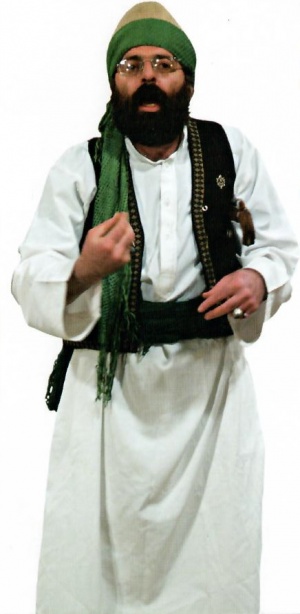Seyyed hossein havaeji
Seyyed Hossein Havaeji (born in 1967) is a distinguished Iranian Pardekhan and T’aziyakhan. Morshed Seyyed Hossein Havaeji is acknowledged, master of both curtain-storytelling and Zurkhaneh (palestra). His understanding of actions of gymnasium (Zurkhaneh) helps him in performing specific movements with variety in visual expression. In his performance the hands and in general the body are extremely active, and for most concepts a body activity and movement can be seen.
Seyyed hossein havaeji | |
|---|---|
 | |
| Born | 1967 Hamedan |
| Nationality | Iranian |
| Known for | Pardekhani, Naqqali and Maddahi |
| Patron(s) | Naqi Sabbaq Hamedani, Darvish Qadir and Hossein Jalali |
Performance Method
Some of his theatrical motions involved are: - emphasis on indicating portraits, events and places with the index finger. - combination of hand and cane to show the shooting and spear and mace-throwing and indicating the farthest points of the curtain or the real world. - showing the spaciousness of time and space by opening the arms and opening the hands facing front. - bowing in the battle scenes. -bowing forward and leaning on the cane for moments of thought and rest during the beginning of scenes. – planned movements specially towards the audience and the curtain to evoke attention, fear, surprise, compassion.
Reciting Method
In this performance, in the hemistich Ey amiri ke alamdar e shah e Karbobala ... he sings the intervals that evoke Chahargah atmosphere (the third and fourth notes of first Dong to the third note of the second Dong) and ends on the Shahed note. This note is due to the structural space constantly in juxtaposition to the Shahed but in this section it is not performed and so a complete cadence in Chahargah is not evoked.
Chahargah final note and Shahed In this section Morshed Havaeji sometimes sings on a lower pitch which consequently he reaches the Shur mode and descending on its Shahed note. From the Saqqa nashenid az ... section the third note of the Chahargah Pishdong is completely lowered a quarter tone in the performance and the Pardekhan's tone finds the intervals of Shur Dastgah (mode) and ends on a Shur characterized by a Shahed on the second note of the Pishdong of Chahargah. The verses continue with similar melodies. The third note of Pishdong is performed in a varied manner and in the ... Mohit e adab... hemistich the Pishdong of the Chahargah Dastgah changes to the first Dong of Shur Dastgah and it descends on the Shahed note of Shur. In the Cho shod moseme harb e al e nabi ... hemistich the notes of the first Dong of Homayun Dastgah (mode) have been used with emphasis on the second note along with Rajaz [1] rhythm. The verse of Arteshbod-e sultan-e din...is performed in the intervals which because of the melodic modulation is near to Segah Dastgah. But from the Ham az emam... hemistich the intervals used by the singer-narrator become extended and descends in the Homayun Dastgah. [2] [3] Temporary Ist (end note) - in some cases in various performances of Homayun Dastgah, especially in vocal pieces, this is used for a complete cadence. The present curtain-storytelling is one of these cases.
Source
- Ardalan, hamidreza (2008). Picture-storyteller masters of iran, the Iranian academy of the art, 2008, volume 28. ISBN: 978-964-2986-101(vol.28). 978-964-2986-002(set).
Reference
- ↑ Rajaz is a kind of recitation of poetry with the same metre as Shahnameh. In Chargah Dastgah there is a Gusheh called Rajaz with the same rhythm and metre.
- ↑ Pishdong intervals of Segah mode correspond to the intervals preceding the first Dong of Homayun but their Dongs do not correspond to each other.
- ↑ Some of the Gushes in Dastgahs and Avazes are common to each other and only in one ending does the identity of the Dastgah become revealed.